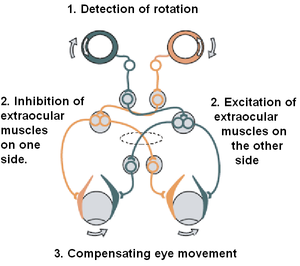SoCal dad....agree about the videos. There is a book, Keep Your Eye On The Ball by Robert G. Watts/ A. Terry Brahill. A quote from the book page 181.
"We have often heard the batting axiom "Don't move your head." So we thought the vestibulo-ocular system would not be used when tracking a baseball. However, in monitoring the eyes of the professional ballplayer, we detected a small vestibulo-ocular eye movements to the left during the early part of the ball's trajectory, as the head was moving to the right, this appears as the downward deflection between 0.8 and 1.1 in the eye trace of Figure 61a. At this point, the head position was changing faster than the angular position of the ball, and the vestibulo-ocular eye movements compensated for the premature head movement. The batter was apparently giving his head a head start. Why would he want to do this? Because the head is heavier than the eye and consequently takes longer to get it moving; therefore, in the beginning of the movement, as the head starts turning to the right (ahead of the ball), the vestibular system in the inner ear signals the oculomotor system to make compensating leftward eye movement. This allows the head to start turning while the gaze remains fixed on the ball."
"However, this vestibulo-ocular compensation must soon stop. In the last half of the ball's flight, the eye and head must both be moving to the right, and the batter must, therefore, suppress his vestibulo-ocular eye reflex, so that the tracking head movement does not produce compensating eye movements that would take his eye off the ball. The professional athlete was very good at suppressing his vestibulo-ocular reflex."
At the garage we have a strobe light set above the tee. Unless the hitter turns the head slightly to the right and we use the nose as an indicator of direction, they will not hit a ball that is soft tossed. I have the parent / coach stand directly behind me so they can see when they turn the head slightly they hit the ball and when they do not they swing over the top of the ball.
When I soft toss the hitter looks at a black rectangle on the wall through the net. When my hand lowers they say EEEE and load and when I release the ball they say R and stride. At the stride is when they turn the head slightly and then the eyes. They give the eyes a head start. I will then make a fist and that is for zero or show one finger or two and they have to call it out as they hit the ball. If they can not see my fingers they will not hit the ball squarely and usually hit the top of the ball.
Also Dr. Bill Harrison, a vision specialist has been helpful over the years in helping me understand this. He was the one that gave me the idea about gluing a white rag inside the tee to help them to track the ball to the tee and then see the white rag after they hit it off the tee.
This might also help...[h=1]Vestibulo-ocular reflex[/h]
From Wikipedia, the free encyclopedia


The vestibulo-ocular reflex. A rotation of the head is detected, which triggers an inhibitory signal to the
extraocular muscles on one side and an excitatory signal to the muscles on the other side. The result is a compensatory movement of the eyes.
The vestibulo-ocular reflex (VOR) is a reflex eye movement that stabilizes images on the retina during head movement by producing an eye movement in the direction opposite to head movement, thus preserving the image on the center of the visual field. For example, when the head moves to the right, the eyes move to the left, and vice versa. Since slight head movement is present all the time, the VOR is very important for stabilizing vision: patients whose VOR is impaired find it difficult to read using print, because they cannot stabilize the eyes during small head tremors. The VOR does not depend on visual input and works even in total darkness or when the eyes are closed. However, in the presence of light, the fixation reflex is also added to the movement.[SUP][1][/SUP]
Hope this helps Howard


